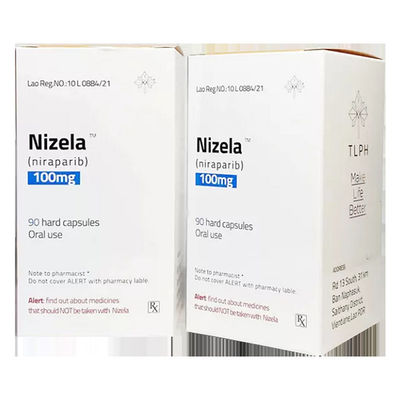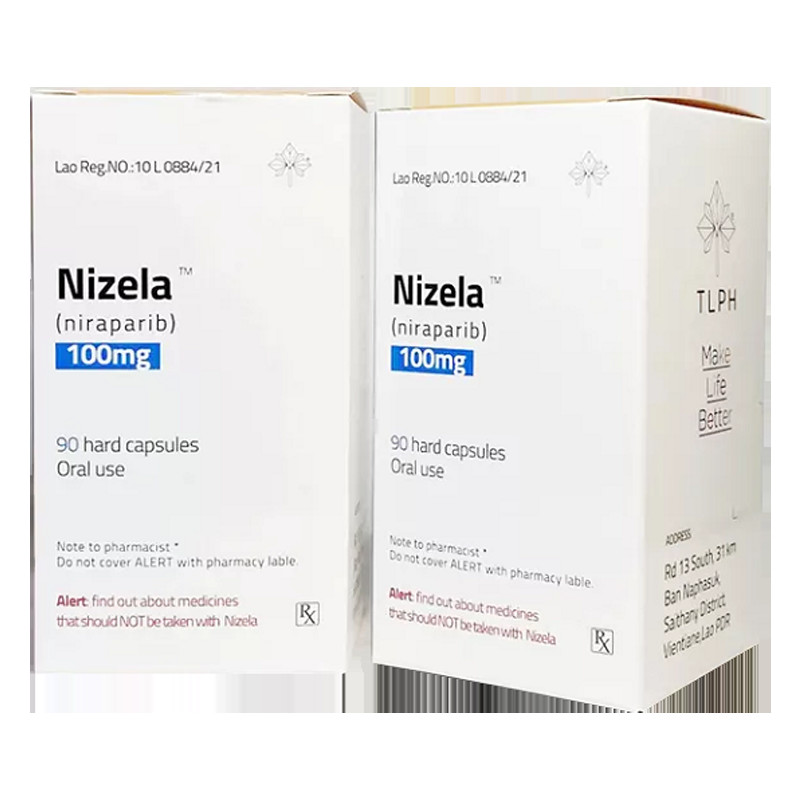100mg Nizela Niraparib Ovarian Cancer Treatment Drugs 30 Capsules
【Drug Name】
Generic name: niraparib tosylate capsules
Product name: Zele®
English name: Niraparib Tosilate Capsules
Chinese Pinyin: Jiaben Huangsuan Nilapali Jiaonang
【Indications】
This product is suitable for maintenance treatment of adult patients with advanced epithelial ovarian cancer, fallopian tube cancer or primary peritoneal cancer who have achieved complete response or partial response to first-line platinum-containing chemotherapy.
This product is suitable for maintenance treatment of adult patients with platinum-sensitive recurrent epithelial ovarian cancer, fallopian tube cancer or primary peritoneal cancer after achieving complete or partial response to platinum-containing chemotherapy.
【Dosage】
This product should be used under the guidance of doctors experienced in the use of anti-tumor drugs.
dose
First-line maintenance treatment of ovarian cancer: For patients with a body weight <77 kg or a baseline platelet count <150,000/μL, the recommended dose of this product is 200 mg orally once daily; for patients with a body weight ≥77 kg and a baseline platelet count ≥150,000/μL, this product is The recommended dose of the product is 300 mg orally once daily until disease progression or intolerable adverse reactions occur. Patients should begin treatment with this product within 12 weeks of completion of platinum-containing chemotherapy.
Maintenance treatment of recurrent ovarian cancer: The recommended dose of this product is 300 mg orally once daily until disease progression or intolerable adverse reactions occur. Patients should begin treatment with this product within 8 weeks of completion of platinum-containing chemotherapy.
Patients are advised to take the medication at approximately the same time each day and the tablets should be swallowed whole. This product can be taken with a meal or on an empty stomach. Giving it at bedtime may control nausea.
If the patient vomits or misses a dose, an additional dose should not be taken but the next prescribed dose should be taken at the usual time the next day.
Dose adjustment for adverse reactions
Recommended dose adjustments for adverse effects are listed in Table 1, Table 2, and Table 3.
Typically, it is recommended to first suspend treatment (but the suspension should not exceed 28 days) until the adverse effects resolve, and then restart treatment at the same dose. If adverse reactions occur again, it is recommended to lower the dose. If adverse reactions persist after a 28-day dosing suspension, it is recommended to discontinue this product. If drug suspension and dose reduction cannot control adverse reactions, permanent discontinuation of the drug is recommended.
▼ Table 1: Recommended dose adjustments for adverse reactions
Starting dose level 200 mg 300 mg
Initial dose reduction 100 mg/day 200 mg/day
Second dose reduction, discontinuation 100 mg/daya
a If further dose reduction to less than 100 mg/day is necessary, discontinue this product.
▼ Table 2: Dose Adjustments for Non-Haematological Adverse Reactions
CTCAEa Grade ≥3 non-hematological adverse reactions when no preventive measures are available or persist despite treatment
Suspend taking this product for no more than 28 days until adverse reactions subside.
Refer to Table 1 to resume treatment at the reduced dose.
Permanently discontinue treatment in patients who develop a CTCAE grade ≥3 treatment-related adverse reaction lasting more than 28 days at the 100 mg/day dose.
a CTCAE=Common Adverse Event Evaluation Criteria
▼ Table 3: Dose Adjustments for Hematological Adverse Reactions
Monitor complete blood count (CBC) weekly during the first month of treatment, monthly for the next 11 months, and regularly thereafter.
Platelet count < 100,000/µL
First occurrence:
Withhold this product for no more than 28 days and monitor blood counts weekly until platelet counts return to ≥ 100,000/µL.
Refer to Table 1 to resume treatment with this product at the same dose or at a reduced dose.
If the platelet count is < 75,000/µL, resume treatment with this drug at a reduced dose.
The second time it happens:
Withhold this product for no more than 28 days and monitor blood counts weekly until the platelet count returns to 100,000/µL.
Refer to Table 1 to resume treatment with this product at a reduced dose.
If platelet counts do not return to acceptable levels within the 28-day dosing pause period or the dose has been reduced to 100 mg once daily, permanently discontinue treatment.
Neutrophils < 1,000/µL or hemoglobin < 8 g/dL
Withhold this product for no more than 28 days and monitor blood counts weekly until the neutrophil count returns to ≥ 1,500/µL or the hemoglobin returns to ≥ 9 g/dL.
Refer to Table 1 to resume treatment with this product at a reduced dose.
Discontinue this product if neutrophil and/or hemoglobin counts do not return to acceptable levels within the 28-day dosing pause period or if the patient has had the dose reduced to 100 mg once daily.
Hematological adverse reactions requiring blood transfusion or hematopoietic growth factor support
Platelet transfusion should be considered in patients with platelet counts ≤10,000/μL. if it exists
For other bleeding risk factors, such as concomitant use of anticoagulants or antiplatelet drugs, consider suspending use
with these medications and/or blood transfusions if the platelet count is higher.
Resume treatment with this product at the reduced dose.
Diagnosed with myelodysplastic syndrome (MDS) or acute myeloid leukemia (AML)
Discontinue use of this product permanently.
underweight patients
Approximately 25% of patients in the NOVA study weighed less than 58 kg, and approximately 25% weighed greater than 77 kg. The incidence of grade 3 or 4 drug-related adverse reactions was greater in patients with low body weight (78%) than in patients with high body weight (53%). Only 13% of underweight patients remained on the 300 mg dose after the third cycle of 28 days. In patients weighing less than 58 kg, a starting dose of 200 mg may be considered.
liver damage
No dose adjustment is required in patients with mild or moderate hepatic impairment. There are no data on patients with severe hepatic impairment and caution should be used in these patients.
renal impairment
No dosage adjustment is necessary in patients with mild or moderate renal impairment. Data are not available in patients with severe renal impairment or end-stage renal disease receiving hemodialysis; caution should be used in these patients.
child
The safety and efficacy of this product have not been established in children and adolescents under 18 years of age.
elderly
In elderly patients (≥65 years), no dose adjustment is necessary. Clinical data are limited in patients aged ≥75 years.
【Adverse reactions】
Serious adverse reactions occurred in 32% of patients treated with niraparib. Serious adverse reactions >2% were thrombocytopenia (16%), anemia (6%), and small bowel obstruction (2.9%). Fatal adverse reactions occurred in 0.4% of patients, including intestinal perforation and pleural effusion (1 patient each).
Among patients treated with niraparib, 12% permanently discontinued treatment due to adverse reactions. Adverse reactions leading to permanent discontinuation in >1% included thrombocytopenia (3.7%), anemia (1.9%), nausea, and neutropenia (1.2% each). Adverse reactions resulted in dose reduction or dosing suspension in 80% of patients, with the most common being thrombocytopenia (56%), anemia (33%), and neutropenia (20%).
【Storage】
Seal and store below 25℃.


 Your message must be between 20-3,000 characters!
Your message must be between 20-3,000 characters! Please check your E-mail!
Please check your E-mail!  Your message must be between 20-3,000 characters!
Your message must be between 20-3,000 characters! Please check your E-mail!
Please check your E-mail! 



